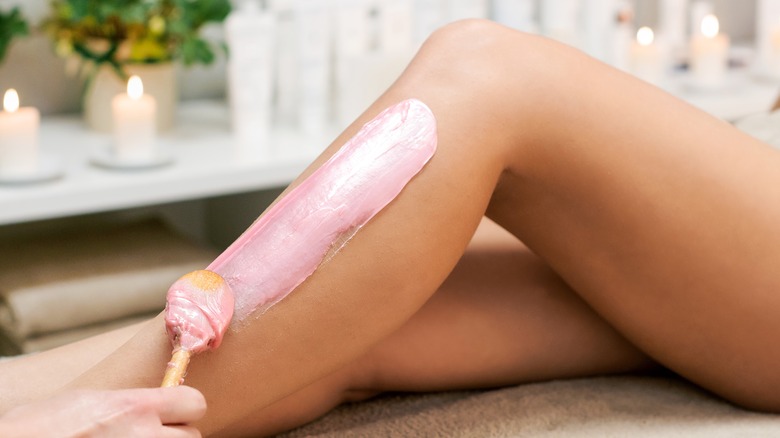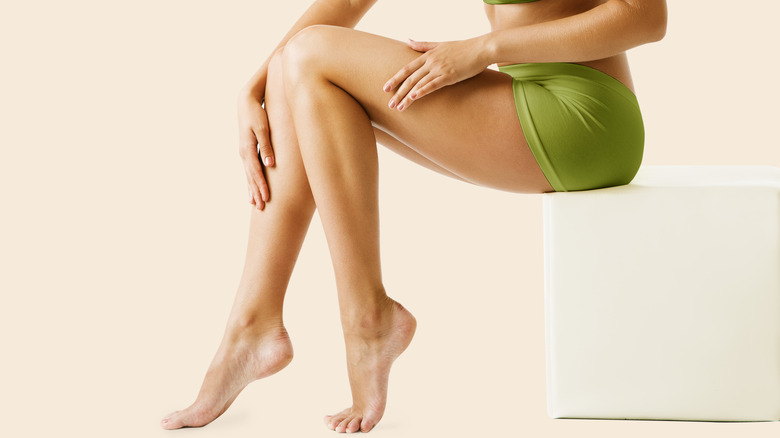How To Wax Your Legs Like A Pro
Originating in Egypt dating back to 3000 B.C., waxing is a beauty treatment that inflicts excruciating pain in return for hairless and smooth skin. From brows to legs to the underarms and the bikini area, there are many parts of the body that you can wax. Waxing is a procedure where a warm, sticky mixture is applied to the skin with a strip atop that is then stripped away once it's cool, per Healthline. Your hair is pulled from the root against the direction of growth through these sticky strips, allowing your waxed areas to be free of hair for as long as six weeks. Dry and dead skin cells are also sloughed off your skin during the process. According to Crown Beauty Bar, there are two main types of waxes: soft wax and hard wax. Hard wax can firm up on its own and may be removed by hand, which makes it less unpleasant to remove than soft wax. It's applied using a waxing spatula and then removed with a cloth strip.
Generally speaking, waxing can give your skin a sleek look and smooth feel, affording you the confidence to wear outfits that reveal the sexy, waxed areas. You can get professional hair removal through a waxing service, which can be relatively costly, or you can give yourself an in-home waxing treatment. In case you've heard way too many scary old wives' tales that make you falter at the idea of waxing, we're here to assure you that there's nothing to fear. Below are some tips that can help you wax like a pro.
Prep your legs for waxing
The most effective approach to waxing is to get yourself a well-equipped at-home waxing kit. Some kits contain only oil strips and applicator sticks, while others come with an electronic wax machine, bags of wax beans, and latex gloves. Depending on your preferences and budgets, you'll find myriad spa-quality waxing kits of varying price ranges and functions online and in drugstores. Some strips work for the facial area and bikini line, while others are meant for the legs.
Before you begin waxing, make sure that the hair on your legs is long enough for the wax to adhere to, like one-fourth of an inch long, Miss Cire advises. Besides, it's a good idea to exfoliate your legs with a gentle body scrub to slough off dead skin before waxing. If you have a low threshold for pain, taking a pain reliever like Advil, or ibuprofen, or applying cold packs to the skin about half an hour before waxing will help ease the pain. Waxing can't leave you hair-free for good. In a matter of weeks, the hairs will begin growing back, but less thick and much finer, esthetician Diedra Green tells HelloGiggles. In other words, if your goal is to keep hair regrowth in check or sparer, waxing is a good idea.
How to apply the wax and avoid skin irritation
Once you're fully prepped, coat a thin layer of wax on a tiny patch of unwanted hair in the direction of your hair growth, The American Academy of Dermatology instructs. If the wax is too thick, heat it in the microwave for five to 10 seconds until it turns into a tacky paste. Then, place a strip over the wax pronto and press it down, leaving the strip on for two to three seconds. After that, pull the strip off in the opposite direction of the hair growth swiftly and decisively. Unlike shaving, waxing does give you a significant level of discomfort as well as side effects, including pain, rash, bumps, scarring, and sun sensitivity. That's why you need post-waxing care. Following a wax, soothe your skin by avoiding hot showers for approximately 24 hours to avoid any potential skin irritation, Waxxpot advises. After a bath in lukewarm water, slather on oil-free moisturizing lotion to keep your skin hydrated. If you have pain in the waxed area, numb it by applying some cold.
Even though waxing might be challenging and unpleasant, there are several advantages if your goal is to have certain areas of your body seem to be hairless. Waxing lasts longer than shaving since the hair is removed from the follicle, leaving your skin feeling smooth and keeping your hair from growing back too rapidly.


